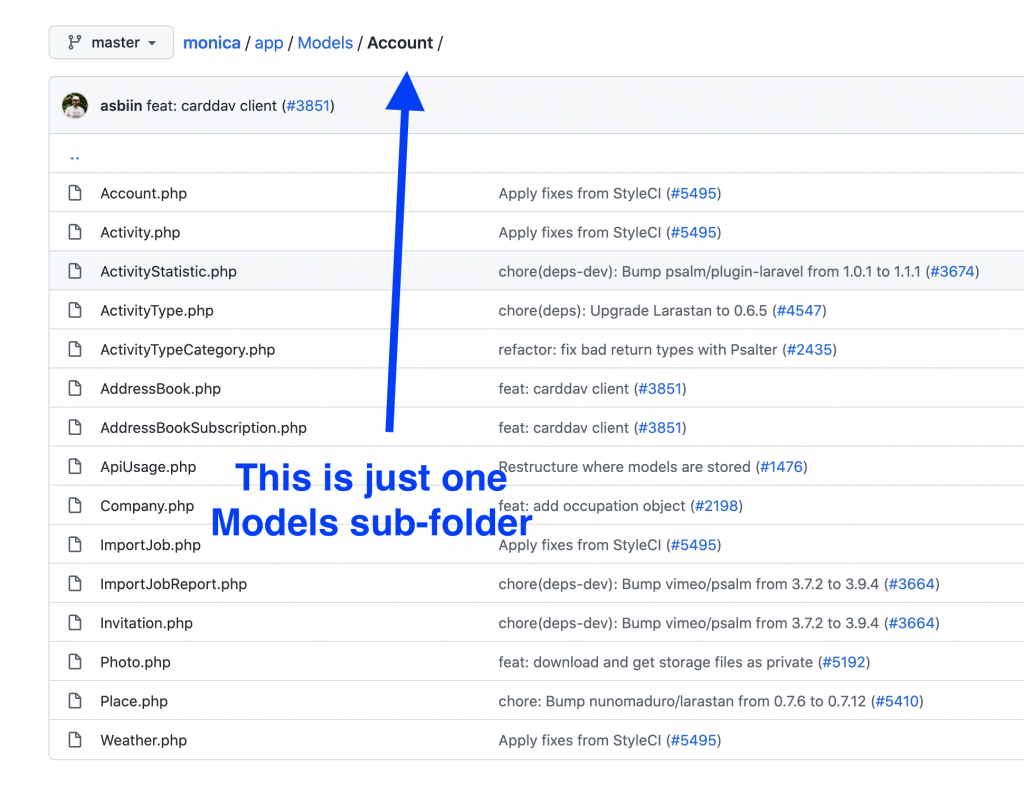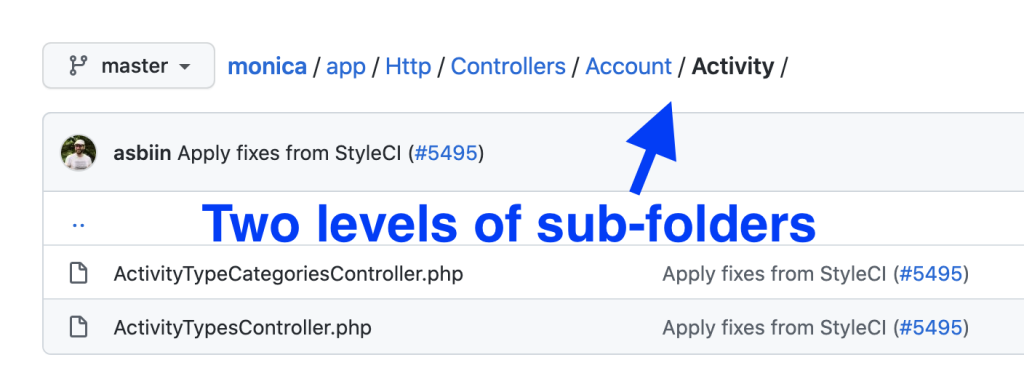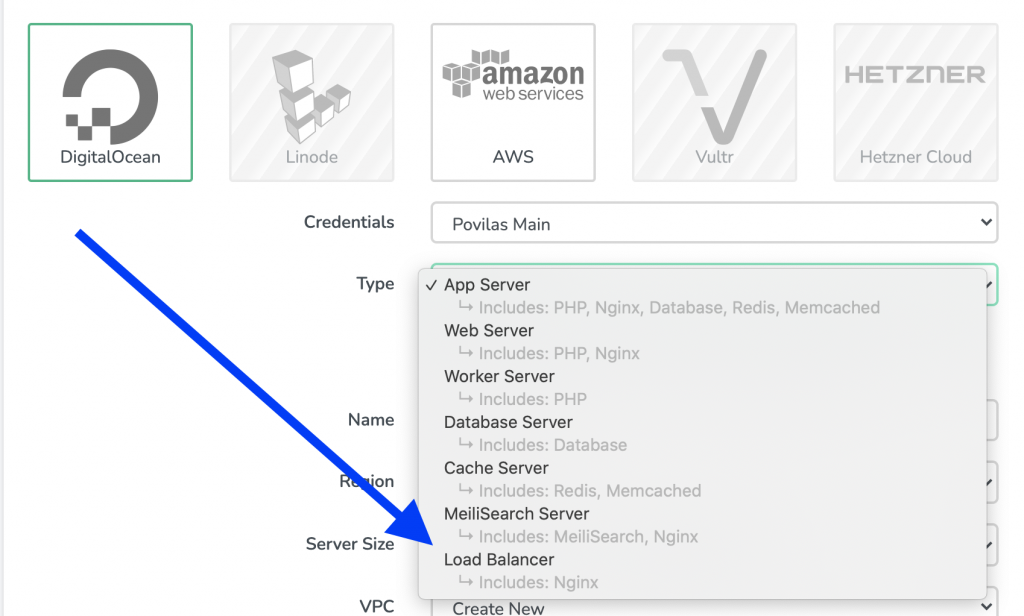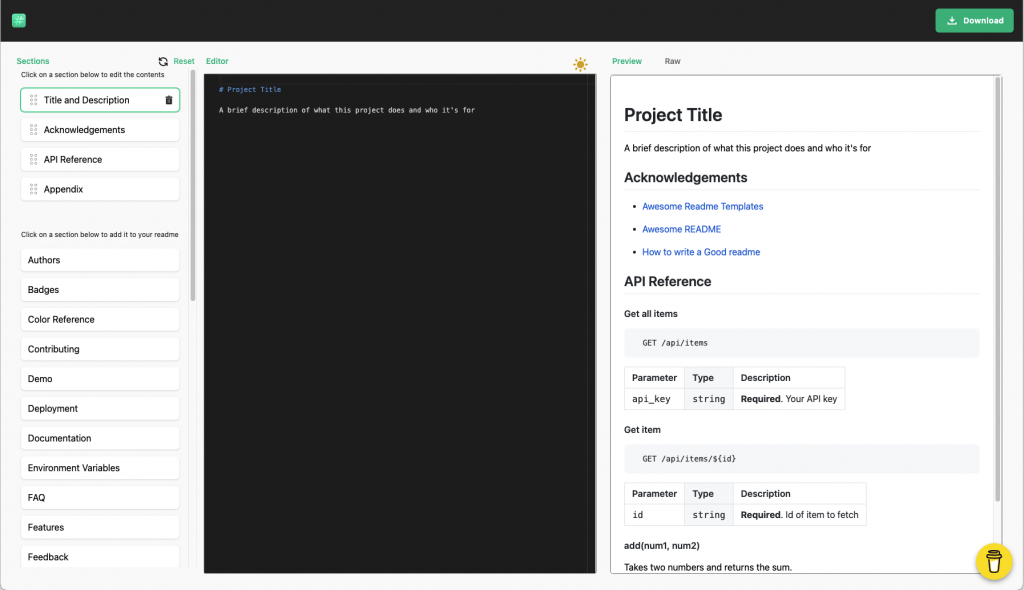https://media.notthebee.com/articles/6155c1b5b22056155c1b5b2206.jpg
Oh my goodness this video is amazing. A work of art. A master-class in self-ownership.
Not the Bee
Just another WordPress site
https://media.notthebee.com/articles/6155c1b5b22056155c1b5b2206.jpg
Oh my goodness this video is amazing. A work of art. A master-class in self-ownership.
Not the Bee
https://laraveldaily.com/wp-content/uploads/2021/09/Larger-Laravel-Projects.png
Probably the most difficult step in the dev career is to jump from simple CRUD-like projects in the early years into some senior-level stuff with bigger architecture and a higher level of responsibility for the code quality. So, in this article, I tried to list the questions (and some answers) to think about, when working with large(r) Laravel projects.
This article will be full of external links to my own content and community resources, so feel free to check them out.
First, I want to explain what I mean by “large”. Some people measure that in the number of database records, like million rows in users table is large. Yes, but it’s a large database, not the Laravel project itself.
What I mean by a larger project is mostly the number of entities to manage. In simple terms, how many Eloquent Models your project has. If you have many models, it usually means complexity. With that, as secondary measurement numbers, you may count the number of routes or public Controller methods.
Example from an open-source Monica CRM project that has 300+ lines of code in routes/web.php file:

With the scope of work this big, there are usually multiple developers working on the project, which brings the complexity to manage the codebase.
Also, a third non-tech feature of a large project is the price of the error. I would like to emphasize those projects where your inefficient or broken code may cause real money to be lost: like 30 minutes of downtime in an e-shop may lose $10,000 to the business easily. Or, some broken if-statement may lead real dozens of people to NOT place the orders.
So yes, I’ll be talking about those large projects below.
In smaller projects, there’s usually a smaller budget and a stronger push to launch “something” quicker, so automated tests are often ignored as a “bonus feature”.
In larger projects, you just cannot physically manually test all the features before releasing them. You could test your own code, yes, but you have no idea how it may affect the old code written by others. Heck, you may even have no idea how that other code or modules work because you’re focused on your parts of the application.
So, how else would you ensure that the released code doesn’t cause bugs? Quite often a new code is just a refactoring of the old code, so if you change something in the project structure, how would you be able to test that nothing is broken? Don’t fall into the mindset I call “fingers-crossed driven development“.
Also, getting back to the definition of a larger project – remember, the price of the bug is high. So, literally, your broken code may cause financial loss to the business. If that argument still doesn’t convince you to cover the code with tests, probably nothing else will.
Yes, I know that typical argument that “we don’t have time to write tests“. I have a full video about it.
But this is where you need to find that time. It involves some communication: evaluate the deadlines thinking about the time to write tests, also talk to the managers about what would happen if you don’t write tests. They will then understand and allow that extra time. If they don’t, it means they don’t care about quality that much, so then maybe time to find another company?
Now, I’m not necessarily talking about a mythical “100% test coverage”. If you are really pressured on time, pick the functions to test that are crucial for your app to work. As Matt Stauffer famously said, “first, write tests for features, which, if they break, would cause you to lose your job“. So, anything related to payments, user access, stability of the core most used functionality.
Ahh, yes, a million-dollar question: how to structure a Laravel project? I even published a 5-hour course on that topic, back in 2019, and I still feel I only scratched the surface there.
There are many different models or ideas that you may follow: divide the project into modules, use the DDD approach, pick some from the design patterns, or just follow SOLID principles. It is all a personal preference.
The thing is there’s no silver bullet and a one-size-fits-all approach. No one can claim that, for example, all bigger Laravel projects should follow DDD. Even SOLID principles sometimes are busted as not the best for some cases.
But the problem is clear: as your project structure grows, you need to change something, and re-structure the files/folders/classes into something more manageable. So what are the essential things you should do?
First, move things into sub-folders and namespace everything accordingly. Again, the example from the Monica CRM is pretty good.

Then, make sure that your classes/methods are not too large. There’s no magic number to follow, but if you feel that you need to scroll up&down too often, or spend too much time figuring out what the class/method does, it’s time to refactor and move the parts of the code somewhere else. The most common example of this is too big Controller files.
These are just two pieces of advice, but just those two changes make your code massively more readable, maintainable, and even more testable.
And yes, sometimes it requires a big “risky” refactoring of classes, but hey, you probably have automated tests to check everything, right? Right?
A topic related to the automated testing we’ve already talked about. If you want to stress-test your application features, you need a large amount of data. And factories+seeds are a perfect combination to achieve that pretty easily.
Just get into the habit of, when creating a new Eloquent model, create a factory and a seed immediately, from the very beginning. Then, whoever will use it in the future to generate some fake data, will thank you very much.
But it’s not only about testing. Also, think about the fresh installation of your application. Large successful projects tend to grow only larger, so you would definitely have to onboard new developers. How much would they struggle with the installation process and getting up to speed, if they don’t have any sample data to work with?
You will also probably need to install your application multiple times on various servers – local, staging, some Docker-based environments, etc. You can customize the seeds to run under the condition of whether it’s a production or local environment.
Although I mentioned in the beginning that database size is not the definition of a large Laravel project, but database structure is a hugely important thing for long-term performance and maintainability.
Which relationships to use? In Laravel terms, should it be a HasOne? HasMany? BelongsToMany? Polymorphic?
Also, other questions. One larger table or several smaller ones? ENUM field or a relationship? UUID or ID column? Of course, each case is individual, and I have a full course on structuring databases, but here is my main short tip.
Try to ask your “future self” about what potential SQL queries will there be on these DB tables, and try to write those queries first.
In other words, think about the end goal, and reverse engineer the structure from that. It would help you to “feel” the correct structure.
If you have factories and seeds ready (notice the pattern of how the topics in this article help each other?), you would be able to easily simulate the future usage, maybe even measure A vs B options, and decide on which is the correct one. This moment is actually very important: changing the DB structure in the future, with a large amount of live data, is probably one of the most complex/expensive/risky changes to make. So you better make a good decision up front.
That said, you shouldn’t be afraid to refactor the database if there’s a real need for that. Move some data into a separate less-used table, change HasMany into Polymorphic, choose other column types, etc.
Just make sure you don’t lose any customer data.
When you choose what Laravel/PHP packages to include in your composer.json, in the very beginning it’s pretty easy: just use the latest versions of everything, and make sure the package is useful.
But later, when the project is alive for a year or two, there’s a need to upgrade the versions. Not only Laravel itself but also the packages, too.
Luckily, Laravel switched to a yearly release schedule from 6-months (and later moved Laravel 9 release to be in sync with Symfony), so developers don’t have that headache every 6 months anymore.
Generally, the framework itself has a pretty stable core, and the upgrades to new versions are relatively easy, should take only a few hours. Also, a service called Laravel Shift is a huge helper for developers who want to save time on this.
But the problem arises from the packages you use.
Pretty typical scenario: you want to upgrade the project to a new Laravel version, but a few packages from your composer file haven’t released their new versions yet to support that Laravel upgrade. So, in my experience, project upgrades are happening at least a few months after the official Laravel release, when the package creators catch up.
And, there are worse scenarios: when the package creator doesn’t have time to release the upgrade (remember, most of them do it for free, in their spare time), or even abandon the package. What to do then?
First, of course, you can help the creator, and submit a Pull Request with the suggested upgrade (don’t forget to include automated tests). But even then, they need to review, test, and approve your PR, so I rarely see that happening in real life. The packages are either actively maintained, or close to abandoned status. So, the only reasonable solution then is to fork the package and use your own version in the future.
But, an even better decision, is to think deeper at the time of choosing what packages to use. Questions to ask are: “Do we REALLY need that package?” and “Does the package creator have a reputation of maintaining their packages?“
If the project becomes successful, its database grows with more data, and the server needs to serve more users at a time. So then, the loading speed becomes an important factor.
Typically, in the Laravel community, we’re talking about performance optimization of Eloquent queries. Indeed, that’s the no.1 typical reason of performance issues.
But Eloquent and database are only one side of the story. There are other things you need to optimize for speed:
– Queue mechanism: your users should not be waiting for 5 minutes for the invoice email to arrive
– Loading front-end assets: you shouldn’t serve 1 MB of CSS/JS if you can minimize it
– Running automated tests suite: you can’t wait for an hour to deploy new changes
– Web-server and PHP configuration: users shouldn’t be “waiting in line” while other 10,000 users are browsing the website
– etc.
Of course, each of those topics is a separate world to dive deep in, but the first thing you should do is set up a measurement and reporting system, so you would be notified if there’s a slow query somewhere, a spike in visitors at some time or your server is near CPU limit.
In a typical smaller project, you can deploy new changes by just SSHing to the server and running a few git and artisan commands manually.
But if you have bigger traffic and a larger team, you need to take care of two things:
– Zero-downtime deployment: to avoid any angry visitors that would see the “deploying changes…” screen, and collisions for visitors pre-post deployment. There’s the official Envoyer project for this and a few alternatives.
– Automatic deployments: not everyone on your team has (or should have) SSH access to production servers, so deployment should be a button somewhere, or happen automatically, triggered by some git action
Also, remember automated tests? So yeah, you should automate their automation. Sounds meta, I know. What I mean is that tests should be automatically run before any deployment. Or, in fact, they should be run whenever new code is pushed to the staging/develop branch.
You can schedule to perform even more automated actions at that point. In general, automation of this build/deploy process is called Continuous Integration or Continuous Delivery (CI/CD). It reduces some stress when releasing new features.
Recently, the most popular tool to achieve that became Github Actions, here are a few resources about it:
– Build, Test, and Deploy Your Laravel Application With GitHub Actions
– How to create a CI/CD for a Laravel application using GitHub Actions
But it’s not only about setting up the software tools. The important thing is the human factor: every developer should know the deployment process and their responsibility in it. Everyone should know what branch to work on, how to commit code, and who/how closes the issues. Things like “don’t push directly to the master branch” or “don’t merge until the tests passed” should be followed on the subconscious level.
There are also social norms like “don’t deploy on Fridays”, but that is debatable, see the video below.
If your project reaches the stage of being very popular, it’s not enough to optimize the code performance. You need to scale it in terms of hardware, by putting up more server power as you need it, or even upsizing/downsizing based on some expected spikes in your visitor base, like in the case of Black Friday.
Also, it’s beneficial to have load balancing between multiple servers, it helps even in case one of the servers goes down, for whatever reason. You can use Laravel Forge for this, see the screenshot below.

Also, don’t forget the scaling of external services. There are separate infrastructure hardware solutions to power your File Storage, Queues, Elasticsearch/Algolia, Socket real-time stuff, Databases, etc. It would be a huge article on each of those areas.
There are so many various tools out there that I can’t really recommend one, in particular, everything depends individually on your project needs, your budget, and your familiarity with a certain ecosystem.
The obvious server-power leader of the world is Amazon with their AWS Ecosystem, but often it’s pretty hard to understand its documentation, there are even explanation websites like AWS in Plain English.
Also, there’s a relatively new “player” in town, called serverless. It became a thing in the Laravel world with the release of Laravel Vapor – a serverless deployment platform for Laravel, powered by AWS.
Probably the best resource to get deeper into this whole scaling world is the course Scaling Laravel.
Everyone probably knows that you need to perform regular backups of your database. And, on the surface, it’s pretty easy to do with a simple Spatie Laravel Backup package:
And, of course, you need to automate it, like “set it and forget it”. But, an important question is have you tried the recovery from that DB backup, at least once?
You need to actually test the scenario: what if your current DB server totally dies, or someone drops the whole production database, and all you have is that backup SQL. Try to actually run the import from it, and test if nothing breaks. If there’s a problem with a backup recovery, you better know it before the disaster happens.

Also, it gets more complicated when you have multiple Database servers, replication, and also you want to not slow down your server while the backup is in progress. So you may tweak the process or use some database backup tools directly, even outside the Laravel world.
Of course, the larger the codebase, the bigger probability of bugs happening. Also, when there are dozens of features, developers can’t test them all themselves, and even automated tests don’t catch all the possible scenarios and cases. Bugs happen to real users of the system, in the wild.
Your goal as a team is to monitor them and be informed when they happen. There are various tools to help with that, I personally use Bugsnag, but there’s also Flare, Sentry, Rollbar – all of them perform pretty much the same thing: notify you about the bugs, with all possible information that helps to trace and fix that bug.
But again, it’s not only about setting up the tool, it’s about the human factor, as well. The team needs to know the process of who reacts to what bug and how exactly: which bugs are urgent, which ones can be postponed, or totally ignored.
Also, the question “Who’s on duty today” is pretty relevant: if the bug tracking software notifies about something, who needs to get that message and via which channel? In our team, we use Slack notifications, and then ideally the situation should be fixed by the developer responsible for that part of the application which is buggy. Of course, in reality, it doesn’t happen all the time, but at least the team needs to know the time-to-react goals.
There’s also another part of the team: non-tech people. Developers need to be in touch with customer support people, and with managers, informing them about the severity and the status of the situation, so the “front-facing” people would talk to the customers accordingly.
This question is kinda obvious, so I won’t explain it in too much detail. In addition to generally avoid getting hacked, probably the most important thing is to secure the personal data of your users – both from other users in multi-tenant systems and from the outside world.
I recommend reading this article: How to Protect Your Laravel Web Application Against the OWASP Top 10 Security Risks
Also, I recommend trying to hack yourself. Yes, I’m not kidding – ask some trusted friend/company from the outside to break into your app and do some damage. Heck, even pay for that – there are companies specializing in this area. Of course, you could try to do it yourself, but, as the author of the code, you’re kinda biased, and you probably wouldn’t try something unusual as a typical hacker would.
Finally, I’d like to express my happiness about the fact that we don’t need to explain the need for an SSL certificate anymore: with browser warning changes, and with free tools like Let’s Encrypt, there’s no excuse to not have https:// in your website.
The final point in this big article is about people. If you work on the project not from its first day, remember the day when you were introduced to it. Do you remember the feeling of installing everything, reading the docs, playing around with testing data, trying to understand how things work?
Now, imagine the mind of a new developer doing that on the current project, which is not much more complex. So, you need to help those poor guys, as much as you can.
I would suggest to even become that “new developer” for a day. When was the last time you tried to install your application, from the ground up? On a new computer or re-installed OS, for example. So yeah, try that, you may get a few unpleasant “surprises” to fix.
Things like installation instructions in Readme (maybe even with Docker images), comments in the code, making the code “clickable” in the IDE, understandable messages in git commits – all of that should be taken care of. And, remember when we talked about factories and seeds? Yes, that applies here, massively.
By the way, there are tools to help you, like this Readme generator.

And it’s not only about totally new developers – the same may happen to any existing team member who needs to fix something in the module that they hadn’t seen before. Any help is appreciated.
What do you think about these 12 questions? I tried to provide short comments and external links, but obviously, it’s just an overview. Would you add any more questions to this list? Or, maybe you have a particular question you want me to expand on, in future articles/videos? Shoot in the comments below.
Laravel Daily
https://tighten.co/assets/img/blog/a-project-managers-top-tips-for-digital-project-management-success-feature-image.png
Just as each workday is a little different, the same can be said about digital projects. Some digital projects are big and require large teams, months of collaboration, and brand new everything to bring them from beginning to end. Some come and go in a matter of weeks and may require a single developer and little oversight. And then there’s everything else left in between. Not to mention clients, partner agencies, the other projects your team is working on, bugs that are about as easy to catch as an actual fly, timelines that won’t slow down for a single second, and a hundred other things that pop up—unexpectedly and not—from the first kickoff meeting. So what’s a project manager to do?
You’ve heard it before. There’s no such thing as overcommunication. But what does that mean? Does it mean relaying every moment in your team’s working day? Nope. Does it mean answering client questions with monosyllabic answers? Also, nope. Does it mean staying in touch with intention, asking the right questions and using your experience to anticipate problems that are lying in wait? Most definitely! That means discussing your team’s milestones and whether you’re on track to hit them, relaying those questions (there’s no such thing as a bad one, by the way), and figuring out your work plan. Video, chat, email, carrier pigeon, whatever your mode of communication is, keep it open and keep it clear.
If a tree falls in a forest, does it make a sound? Of course it does. Squirrels have ears, after all. If a project doesn’t have clearly defined goals, can it possibly succeed? Luckily for us project managers, we can get started on setting concrete goals once contracts are signed and approved. At this early stage, we can take advantage of the client’s excitement (our team is about to start making their business vision a reality) while setting manageable expectations that are easy (enough) to shift as the project takes off. To do this, set your dial to the “direct” setting. For example, I’d suggest asking ‘What’s your number one goal for this project’? The answers to these questions will help you create a to-do list while building the foundation for success for all your team members. And that includes you!
The more those goals are defined with specifics, the easier it is to have a vantage point for all decision-making as the project evolves.
Now that we have those oh-so-specific answers to our very direct questions, it’s time to prioritize them. Much like any thorough checklist, clients often come to the drawing board wanting EVERYTHING ALL AT ONCE. This is when the art of managing expectations comes into play. To help set expectations throughout any project, it’s helpful to reach early alignment on the absolute top priorities. Don’t be afraid to dig deep and have hard conversations. This is not a “this or that” conversation but is establishing a baseline that we can add to later. This is when we stop being polite (well, not really) and start getting real by figuring out what stays on the to-do list and what moves to the backlog.
Let us never give a woeful sigh that says “I didn’t write it down.” Write. It. Down. It’s more than helpful to take notes during conversations with your team–with any client, it is a necessity. There’s just so much to forget in a moment’s time, much less an intense, hour-long conversation with anyone. As an added bonus, when you take good notes you can then share any action steps with the client after group discussion. That way, everyone has a frame of reference to point back to, and conversations never rely on a distant memory.
Sometimes (all the times?) it’s scary to disagree with a client, but at the end of the day, the client has hired you for your expertise; it’s important to express your opinion about how to best proceed and back up that opinion with your reasons as to why. It may be as simple as spreading the knowledge that QA should be done “early and often” to help ensure there aren’t big gaps left at the end of a project. Not only are you showing your bona fides, you’re making sure your team has a voice even when they’re not at the table.
Not all coffee is tasty, and not all meetings are good. Understanding that is the first step to a successful meeting. The next step? Agendas. A written agenda for any meeting helps you keep the meeting focused on its goals, and helps those joining know what to expect and how to come best prepared. Nothing is worse than showing up to a meeting that could have been an email, or showing up to a meeting only to learn for the first time you are supposed to present. Yeah… Don’t surprise your colleagues and clients. Try instead to use meetings as an expected opportunity for dialogue and not a statement of facts. Outline topics of conversation in your agenda, share it beforehand, and if it’s helpful, give the topics time constraints.
For example, consider a scenario when you’re showing a demo of work to-date. Rather than just simply sharing all progress, you can build excitement by talking through only 1 or 2 key product features while setting time aside to discuss initial feedback and any concerns, and sending the rest of the work after the meeting. During the meeting, you might ask, “Is anything unclear from the user experience?” Or verify, “Should the call to action really go there?” The bottom line is that consistently providing written agendas that outline the main goals/topics of conversation helps everyone understand what to expect each time and sets everyone up for success.
While you’re busy making notes, always make sure to capture those project decisions along the way. Think of it as a mutual point of reference for you and the client. Right about now, you might think, “But, wait, Jeanne, how could anyone forget a decision that was made together?” To which I reply, “Without documentation, did it happen, like the tree falling in the forest?” Even the shortest projects have numerous meetings. Moreover, every day will have off-the-cuff convos, casual Slack exchanges, decisions relayed by other team members… well, you get the picture. Medium story short, the more we document these decisions in a single place that both you and the client can refer to, the less likely wires will get crossed down the line. This is where your handy project management software really earns its salt.
At Tighten, we often like to document decisions in a shared Slack channel with the client, so everyone on the team has the opportunity to provide input and stay up-to-date.
We all learn differently, and the more flexible we can be for the client and each other, the greater opportunity we have to create conditions for a successful outcome where everyone wins. This might mean using different tooling on some days because the client’s team is more comfortable with it. Or it might be something as simple as remembering to keep an open mind as more, and new, information becomes available around project strategies. There is no one correct way, and the more empathy we give to one another, the better.
Of course the team will work collaboratively, but one extra helpful thing is honing and elevating the many strengths of our team members. We all have different strengths, and the more we can lean on each other, the stronger the project will be. Those strengths could be familiarity: a problem someone has solved on numerous occasions. It might be someone who can speak with helpful authority on a particular development quirk. Or it could be as simple as a fresh perspective on a tricky problem. Whatever the case may be, lean into one of our overriding themes of the day: Just ask!
Active feedback and celebration are helpful to a project’s success, especially in remote environments where in-person interactions simply don’t take place. That said, don’t wait until the end of the project to celebrate successes. Don’t focus only on the big milestones. Mindfully appreciate all the work the team puts in each day and call out the small wins along the way. You’re all in this together.
At Tighten, we like simple, repeatable systems, and tools that support doing them well. We enjoy Trello, GitHub, and Slack, but this one is up to you! Do what works best for you and the team, understanding that more often than not there is no one single solution—no matter what the software advertisements tell you.
There you have it. 11 simple steps for successful digital project management of any size. If you have favorite tips or tricks, we’d love to hear them!
Laravel News Links
http://img.youtube.com/vi/0RlYBg6KMsc/0.jpgI decided to make my own life easier, so I would be able to create small demo projects quicker, but also releasing this for free on Github, so maybe you would use them as well.Laravel News Links
https://dev.to/social_previews/article/836547.png
In this Tutorial, we will see how to implement Bulk Action so that User can select and update multiple records using Livewire. This is the part 3 of the Series related to Livewire Table. In Part 2 of the Series we saw how to Hide/Show Columns in a Table using Livewire.
Let us assume we have a Model called as Product and it has a column status. We want to give user the ability to select multiple products and then change the value of status column for all of the selected products.
I would assume that you already have a working Livewire Component which is showing the Records in a Table Form. First of all we are going to add a New Property $selectedProducts to our Livewire Component. This would hold all the Products that user has selected.
public $selectedProducts = [];
Now in the View, we would like to display a checkbox next to each item. We would create a New column and we will paste the following code inside the loop which displays all the Results.
<input type="checkbox" value="" />
This would display the checkbox and we have given it the value which is the Primary Key of the Product Table so as to uniquely identify it.
Now we would link this checkbox to the $selectedProducts using the wire:model.
<input type="checkbox" value=""
wire:model="selectedProducts" />
Now every time a User selects a Product, $selectedProducts would be updated. So at any time $selectedProducts would have all the Products that User has selected for Bulk Action.
Infact, we are going to use wire:model.defer. The defer directives makes sure that our Component will not be re-rendered when the User checks the checkbox. This will result in a significant performance improvement. If you want to learn more about defer and other techniques to improve Performance using Livewire, you can check this Article.
<input type="checkbox" value=""
wire:model.defer="selectedProducts" />
Now we need to create 2 Buttons, Activate and Deactivate. Both these buttons will call a method changeStatus on click. We will pass the value that we want to set for the status column as the parameter. So for Activate we pass 1 and for Deactivate we will pass 0.
<button wire:click="changeStatus(1)">Activate</button>
<button wire:click="changeStatus(0)">Deactivate</button>
Next we need to define this method within our Component. We can define it as follows. Here $status will hold the value that we want to set for the status column. So for Activate it will be 1 and for Deactivate it will be 0.
public function changeStatus($status)
{
}
Within this method we will first of all check, if there are any Records that User has selected using $selectedProducts. Then we will update the status column for all those Products. And then we will finally clear the $selectedProducts variable.
if (!empty($this->selectedProducts)) {
Product::whereIn('id', $this->selectedProducts)->update(['status' => $status]);
$this->selectedProducts = [];
}
And that is all we need to do to give User the Ability to update Records in Bulk.
If you have liked this Tutorial, please checkout the Livewire Package tall-crud-generator which automatically generates all the Code related to Bulk Actions.
Laravel News Links
https://www.ammoland.com/wp-content/uploads/2021/09/duck-hunt-iStock-1301911854-500×334.jpg

U.S.A. -(AmmoLand.com)- NSSF, the firearm industry trade association, is pleased to announce that Trijicon is sponsoring the Trijicon Hunt +ONE Experience Giveaway to focus attention on the importance of mentoring in hunting through NSSF’s +ONE Movement.
The +ONE Movement encourages mentoring of newcomers by experienced hunters and target shooters to pass on the skills and appreciation for these popular outdoor activities. With hunting season approaching, now is a good time to introduce someone new to this great American tradition, and NSSF can help with mentoring and newcomer resources at LetsGoHunting.org.
Trijicon, the Michigan-based optics manufacturer, wants to give someone the hunting experience of a lifetime. The Trijicon Hunt +ONE Experience giveaway includes a fully paid and guided free-range trophy whitetail hunt at Lowrance Ranch in Truscott, Texas with all travel, licenses, lodging, and meals included in the package. The winner of the hunt also receives a Springfield Armory 2020 Waypoint Rifle chambered in 6.5 Creedmoor with a Trijicon Credo HX 2.5-15×42 riflescope to use on the hunt, bringing the total package value to $10,000.
Entries to the sweepstakes are open until October 29, 2021, on the dedicated Sweepstakes page.
“We are grateful for Trijicon’s continued support of the +ONE Movement, which is so important to the future of hunting and recreational shooting,” said Zach Snow, NSSF Director, Member Development. “Trijicon’s efforts help to encourage experienced shooters and hunters to mentor newcomers so they can enjoy these lifelong activities with friends and family.”
“We are excited to further the NSSF +ONE Movement in conjunction with National Hunting & Fishing Day to show our support of the American hunting and conservation model,” said Josh Lyall, Trijicon Director of Marketing. “Trijicon is a company comprised of hunters and target shooters and we are always looking for ways to introduce more people to the world of hunting and shooting sports.”
There are now over 2 million pledges and potential mentees who are part of the +ONE Movement. Individuals and businesses interested in promoting and getting directly involved in the +ONE Movement can visit letsgoshooting.org/plusone and letsgohunting.org/plusone to learn more about the initiative and find ways to get started. Additional +ONE resources can be downloaded and or ordered at nssf.org/plusone.
About The National Shooting Sports Foundation
NSSF is the trade association for the firearm industry. Its mission is to promote, protect and preserve hunting and shooting sports. Formed in 1961, NSSF has a membership of thousands of manufacturers, distributors, firearm retailers, shooting ranges, sportsmen’s organizations, and publishers nationwide. For more information, visit nssf.org

The post Trijicon Supports Mentorship With +One Experience Giveaway appeared first on AmmoLand.com.
AmmoLand.com
https://www.percona.com/blog/wp-content/uploads/2021/09/Horizontal-Scalability-for-MySQL.png
 As a Technical Account Manager at Percona, I get to work with many of our largest clients. While the industry verticals vary, one main core challenge generally remains the same – what do I do with all this data? Dealing with massive data sets in MySQL isn’t a new challenge, but the best approach still isn’t trivial. Each application is obviously different, but I wanted to discuss some of the main best practices around dealing with lakes of data.
As a Technical Account Manager at Percona, I get to work with many of our largest clients. While the industry verticals vary, one main core challenge generally remains the same – what do I do with all this data? Dealing with massive data sets in MySQL isn’t a new challenge, but the best approach still isn’t trivial. Each application is obviously different, but I wanted to discuss some of the main best practices around dealing with lakes of data.
First and foremost, the architecture needs to be designed to keep each MySQL instance relatively small. A very common question I get from teams new to working with MySQL is: “So what is the largest instance size MySQL supports?”. My answer goes back to my time in consulting: “It depends”. Can my MySQL instance support a 20TB dataset? Maybe, but it depends on the workload pattern. Should I store 20TB of data in a single MySQL instance? In most cases, absolutely not.
MySQL can definitely store massive amounts of data. But RDBMSs are designed to store, write, and read that data. When the data grows that large, often the read performance starts to suffer. But what if my working dataset still fits in RAM? This is often the critical consideration when it comes to sizing an instance. In this case, active read/write operations may remain fast, but what happens when you need to take a backup or ALTER a table? You are reading (and writing out) 20TB which will always be bounded by I/O.
So what is the magic number for sizing? Many large-scale shops try to keep individual instance sizes under the 2-3TB mark. This results in a few major advantages:
If I know my instance will never exceed a couple of terabytes, I can fully optimize my systems for that data size. The results are predictable and repeatable operational actions. Now, when a backup is “slow”, it is almost assuredly due to hardware and not being an outlier instance that is double the size. This is a huge win for the operations team in managing the overall infrastructure. In addition to backups, you have the additional consideration of restore time. Massive backups will slow restoration and have a negative impact on RTO.
Now that the negative impact of large, individual instances is known, let’s look at how we keep the sizes down. While seemingly obvious, the best way to keep data sizes small is to store less data. There are a few ways to approach this:
These techniques can help you delay the need for more advanced techniques. However, in some cases (due to compliance, limited flexibility, etc), the above options aren’t possible. In other cases, you may already be doing them and are still hitting size limits.
So what is another way to deal with massive data sets in MySQL? When all other options are exhausted, you need to look at splitting the data horizontally and spreading it across multiple equally sized instances. Unfortunately, this is much easier said than done. While there are some tools and options out there for MySQL (such as Vitess), often the best and most flexible approach is building this sharding logic into your application directly. Sharding can be done statically (key modulus for example) or more dynamically (via a dictionary lookup) or some hybrid approach of the two:

When you finally have to bite the bullet and split data horizontally, there are definitely some things to keep in mind. First and foremost, picking the correct sharding key is imperative. With the wrong key, shards won’t be balanced and you’ll end up with sizes all over the board. This then becomes the same problem where a shard can grow too large.
Once you have the correct key, you need to understand that different workloads will be impacted by sharding differently. When the data is split across shards, individual lookups are generally the easiest to implement. You take the key, map to a shard, and fetch the results. However, if the workload requires aggregate access (think reports, totals, etc), now you are dealing with combining multiple shards. This is a primary and major challenge when looking at horizontal sharding. As is the case in most architectures, the business requirements and workload will dictate the design.
If your team is struggling with an exploding data set, the Professional Services team at Percona can help you design a more flexible and scalable solution. Each case is unique and our team can work with your specific use case and business requirements to guide you in the right direction. The biggest thing to remember: please don’t just keep adding hard disk space to your instances while expecting it to scale. Proper design and horizontal sharding is the critical factor as your data grows!
Percona Distribution for MySQL is the most complete, stable, scalable, and secure, open-source MySQL solution available, delivering enterprise-grade database environments for your most critical business applications… and it’s free to use!
Download Percona Distribution for MySQL Today
Percona Database Performance Blog
http://img.youtube.com/vi/cOzPpGnPCyk/0.jpgI’ve talked a lot about Eloquent on this channel but decided to pick the three most common mistakes related to performance.Laravel News Links
https://plugins.jetbrains.com/files/14957/137820/icon/pluginIcon.pngA free and open source plugin to run PHP code directly as if through Tinker without leaving your favorite IDE. Includes all PhpStorm features you are already used to like code completion, error correction and color scheme.Laravel News Links
https://assets.amuniversal.com/744dff80f250013976ad005056a9545d
Thank you for voting.
Hmm. Something went wrong. We will take a look as soon as we can.
Dilbert Daily Strip